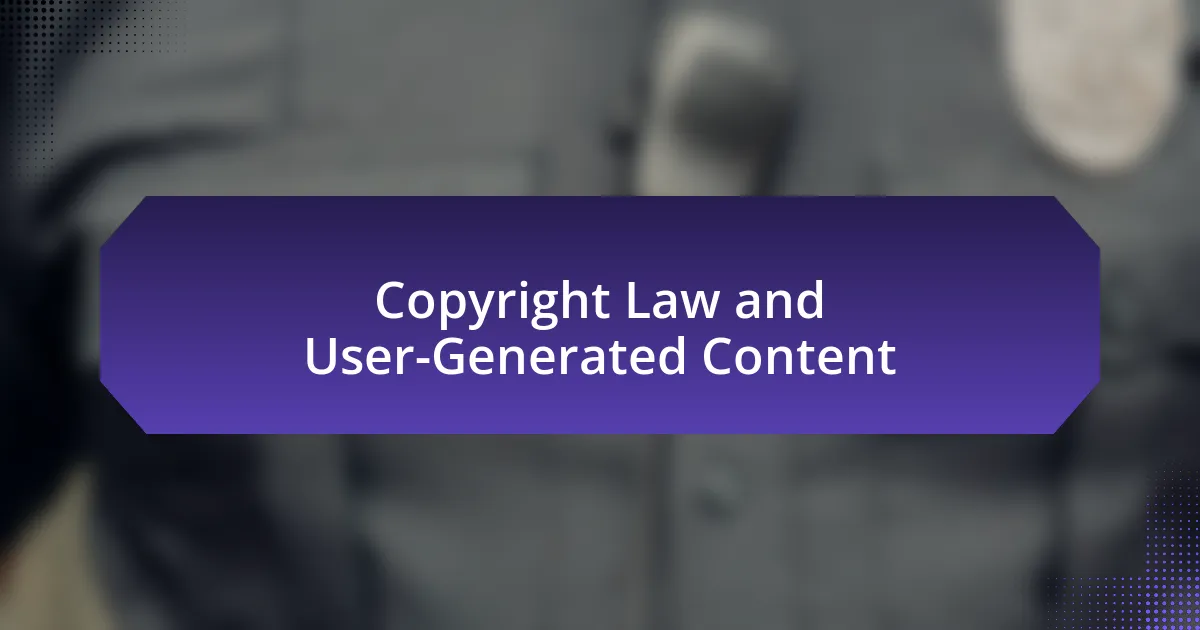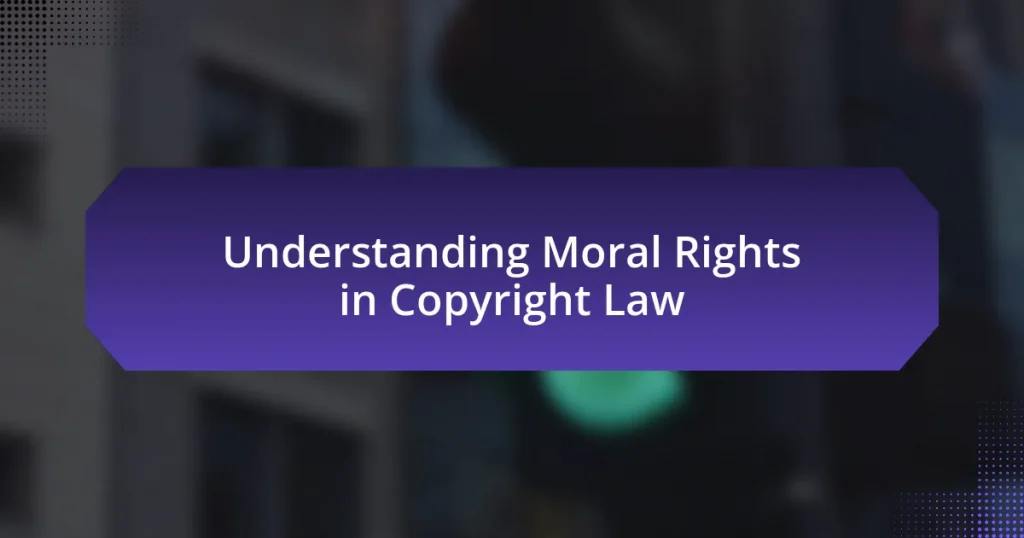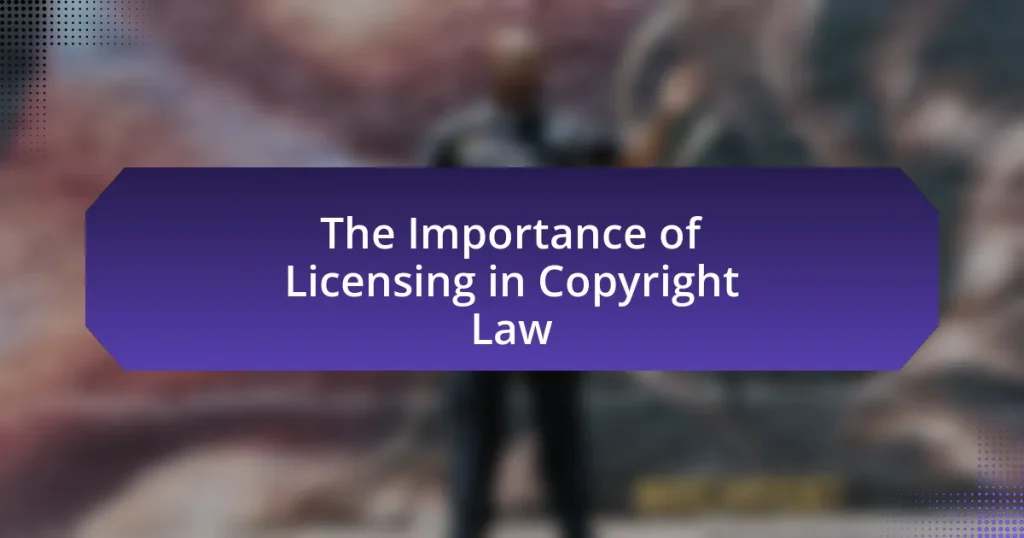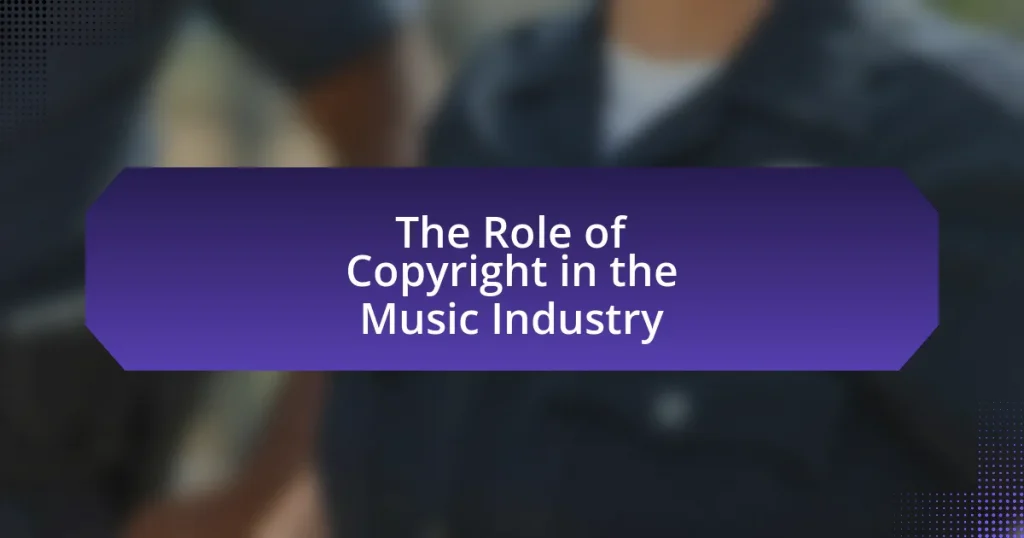Copyright law is a legal framework that grants creators exclusive rights to their original works, including user-generated content such as videos, images, and text shared online. This article explores how copyright law applies to user-generated content, highlighting key principles like originality and fixation, and the rights of creators. It also examines the challenges users face regarding copyright, common issues that arise, and the implications for platforms hosting such content. Additionally, the article provides practical tips for users to protect their rights and navigate copyright laws effectively, ensuring compliance and understanding of their legal responsibilities.
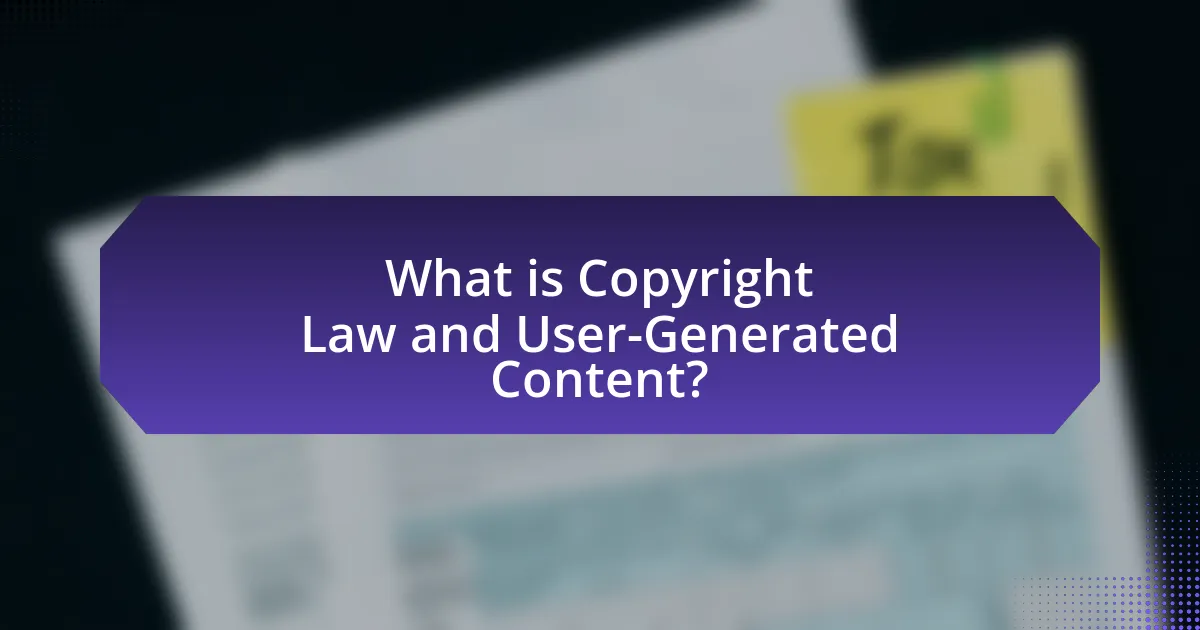
What is Copyright Law and User-Generated Content?
Copyright law is a legal framework that grants creators exclusive rights to their original works, while user-generated content refers to any content created by users of a platform, often shared online. Copyright law protects user-generated content by ensuring that the creators retain rights over their works, preventing unauthorized use or reproduction. For instance, under the U.S. Copyright Act, any original work fixed in a tangible medium is automatically protected, which includes videos, music, and written content produced by users. This legal protection encourages creativity and innovation by allowing individuals to share their work while maintaining control over its use.
How does copyright law apply to user-generated content?
Copyright law grants creators exclusive rights to their original works, which includes user-generated content such as videos, images, and text. When users create and share content on platforms, they typically retain copyright ownership unless they explicitly transfer those rights to the platform or another entity. This ownership allows users to control how their content is used, reproduced, and distributed. However, platforms often include terms of service that may require users to grant a license for the platform to use the content, which can complicate ownership rights. According to the U.S. Copyright Office, user-generated content is protected under the same copyright principles that apply to traditional works, affirming that originality and fixation are key criteria for copyright eligibility.
What are the key principles of copyright law relevant to user-generated content?
The key principles of copyright law relevant to user-generated content include originality, fixation, and the rights of creators. Originality requires that the content must be independently created and possess a minimal degree of creativity. Fixation mandates that the content must be captured in a tangible medium, such as a digital file or video. The rights of creators grant them exclusive rights to reproduce, distribute, and display their work, as established by the Copyright Act of 1976 in the United States. These principles ensure that user-generated content is protected under copyright law, allowing creators to control the use of their work and receive recognition and compensation for their contributions.
How do copyright laws differ across various jurisdictions for user-generated content?
Copyright laws for user-generated content vary significantly across jurisdictions, primarily due to differences in legal frameworks and cultural attitudes towards intellectual property. For instance, in the United States, the Digital Millennium Copyright Act (DMCA) provides a safe harbor for platforms hosting user-generated content, allowing them to avoid liability for copyright infringement if they promptly remove infringing material upon notification. In contrast, the European Union’s Copyright Directive emphasizes the responsibility of platforms to obtain licenses for user-uploaded content, which can lead to stricter enforcement and potential liability for non-compliance. Additionally, countries like Japan have unique provisions that allow for more flexible interpretations of fair use, impacting how user-generated content is treated. These variations highlight the complexities of navigating copyright laws internationally, as creators and platforms must adapt to the specific legal requirements of each jurisdiction.
Why is copyright important for creators of user-generated content?
Copyright is important for creators of user-generated content because it grants them exclusive rights to their original works, allowing them to control how their content is used and distributed. This legal protection encourages creativity by ensuring that creators can benefit financially from their efforts, as they can license their work or receive compensation for its use. According to the U.S. Copyright Office, copyright protection applies automatically upon the creation of a work, which means creators do not need to register their work to have rights, but registration can enhance their ability to enforce those rights in case of infringement. This framework not only safeguards the interests of individual creators but also fosters a vibrant ecosystem of innovation and expression in the digital landscape.
What rights do creators have under copyright law?
Creators have exclusive rights under copyright law, which include the right to reproduce, distribute, perform, display, and create derivative works based on their original creations. These rights are established to protect the interests of creators and incentivize creativity. For instance, the U.S. Copyright Act of 1976 grants these rights automatically upon the creation of an original work fixed in a tangible medium, ensuring that creators can control how their works are used and monetized.
How does copyright protection encourage creativity in user-generated content?
Copyright protection encourages creativity in user-generated content by providing legal assurance that creators can control and profit from their original works. This legal framework incentivizes individuals to produce and share their content, knowing that their intellectual property rights are safeguarded against unauthorized use. For instance, a study by the U.S. Copyright Office indicates that copyright laws foster innovation by allowing creators to monetize their work, which in turn stimulates further creative endeavors. By ensuring that creators receive recognition and financial rewards, copyright protection cultivates an environment where user-generated content can thrive and evolve.
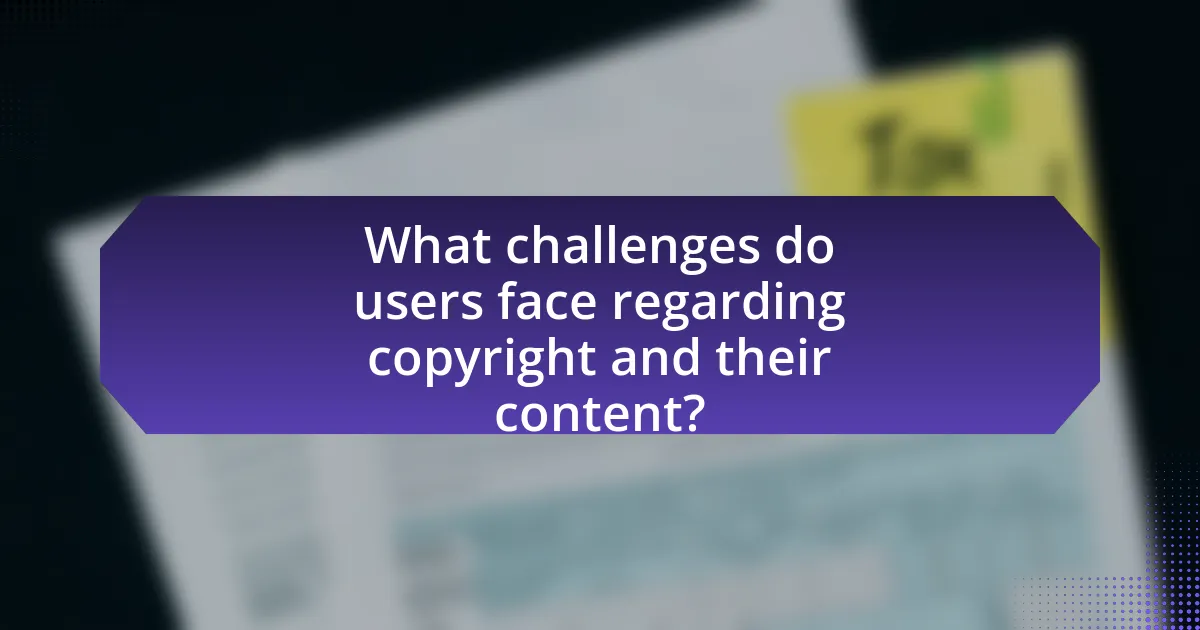
What challenges do users face regarding copyright and their content?
Users face significant challenges regarding copyright and their content, primarily due to the complexity of copyright laws and the risk of infringement. Many users are unaware of the specific rights they hold over their creations, leading to unintentional violations when sharing or using others’ content. Additionally, the digital landscape complicates copyright enforcement, as content can be easily copied and redistributed without permission. According to a 2021 study by the U.S. Copyright Office, nearly 60% of content creators reported confusion about copyright ownership and fair use, highlighting the widespread uncertainty surrounding these issues.
What common copyright issues arise with user-generated content?
Common copyright issues that arise with user-generated content include unauthorized use of copyrighted material, lack of ownership clarity, and potential infringement on moral rights. Unauthorized use occurs when users incorporate copyrighted works, such as music or images, without permission, leading to legal disputes. Lack of ownership clarity often arises when users upload content to platforms that claim ownership rights, creating confusion about who holds the copyright. Additionally, moral rights, which protect the personal and reputational interests of creators, can be violated if user-generated content is altered or used in a way that the original creator disapproves of. These issues highlight the complexities of copyright law in the context of user-generated content.
How can users inadvertently infringe on copyright when creating content?
Users can inadvertently infringe on copyright when creating content by using copyrighted materials without permission, such as images, music, or text. This often occurs when individuals assume that content found online is free to use or fail to properly attribute the original creator. For instance, a study by the Copyright Office indicates that many users do not understand the nuances of fair use, leading to unintentional violations. Additionally, remixing or altering existing works without authorization can also result in copyright infringement, as the original creator retains rights over derivative works.
What are the consequences of copyright infringement for users?
Copyright infringement for users can lead to legal consequences, including monetary damages and potential criminal charges. Users who infringe copyright may face civil lawsuits from copyright holders, resulting in financial penalties that can range from statutory damages of $750 to $30,000 per work infringed, and in cases of willful infringement, damages can escalate to $150,000 per work. Additionally, users may encounter criminal charges that can lead to fines and imprisonment, particularly in cases of large-scale infringement or distribution. The U.S. Copyright Act provides these legal frameworks, emphasizing the seriousness of copyright violations and the protection of intellectual property rights.
How can users protect their own user-generated content?
Users can protect their own user-generated content by registering it with copyright authorities, which grants them legal rights and recognition over their work. Copyright registration provides a public record of ownership and is essential for enforcing rights in case of infringement. Additionally, users should include watermarks or digital signatures on their content to deter unauthorized use. According to the U.S. Copyright Office, registration is not mandatory but significantly strengthens a user’s ability to pursue legal action against infringers. Furthermore, users can utilize licenses, such as Creative Commons, to specify how others may use their content while retaining certain rights.
What steps can creators take to ensure their content is protected by copyright?
Creators can ensure their content is protected by copyright by registering their work with the U.S. Copyright Office. This formal registration provides legal evidence of ownership and is necessary for pursuing infringement claims in court. Additionally, creators should include copyright notices on their work, which inform the public of their rights and deter unauthorized use. Keeping detailed records of the creation process, such as drafts and timestamps, can also help establish ownership. According to the U.S. Copyright Office, registration is not mandatory but significantly enhances the ability to enforce rights and seek damages in case of infringement.
How can users effectively license their user-generated content?
Users can effectively license their user-generated content by clearly defining the terms of use through a licensing agreement. This agreement should specify how the content can be used, whether it can be modified, and if it can be shared or sold. For instance, Creative Commons licenses provide a standardized way for creators to grant permissions while retaining certain rights, allowing users to choose from various options like attribution, non-commercial use, or share-alike conditions. By utilizing these licenses, users can protect their rights while enabling others to use their content legally, which is supported by the increasing adoption of Creative Commons licenses globally, with over 1.4 billion works licensed under their framework as of 2021.
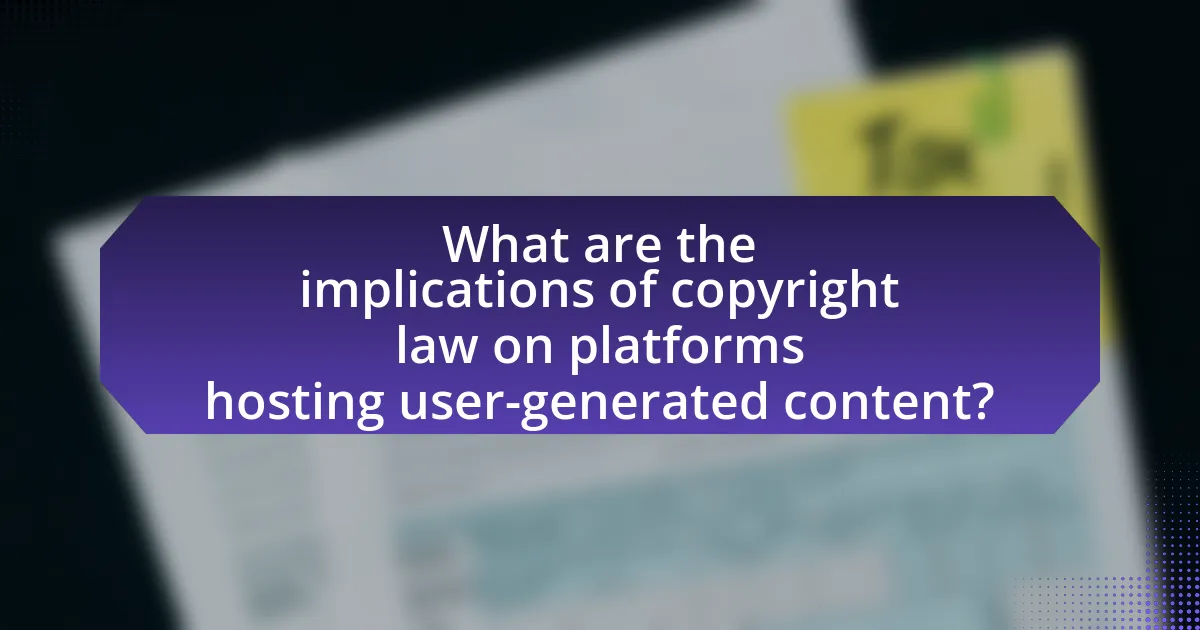
What are the implications of copyright law on platforms hosting user-generated content?
Copyright law significantly impacts platforms hosting user-generated content by imposing legal responsibilities for copyright infringement. These platforms, such as social media sites and video-sharing services, must implement measures to monitor and manage copyrighted material uploaded by users to avoid liability. For instance, the Digital Millennium Copyright Act (DMCA) provides a safe harbor provision, allowing platforms to avoid legal repercussions if they promptly remove infringing content upon notification. This legal framework necessitates that platforms establish effective content moderation systems and user education programs to comply with copyright regulations and protect intellectual property rights.
How do online platforms manage copyright issues related to user-generated content?
Online platforms manage copyright issues related to user-generated content primarily through the implementation of content moderation systems and adherence to the Digital Millennium Copyright Act (DMCA). These platforms utilize automated tools and user reporting mechanisms to identify and remove infringing content, ensuring compliance with copyright laws. For instance, platforms like YouTube employ Content ID technology, which scans uploaded videos against a database of copyrighted material, allowing copyright holders to monetize, block, or track their content. Additionally, platforms often provide clear guidelines for users regarding copyright ownership and the consequences of infringement, fostering a culture of respect for intellectual property rights.
What responsibilities do platforms have under copyright law?
Platforms have the responsibility to monitor and remove infringing content under copyright law. This obligation arises from the Digital Millennium Copyright Act (DMCA), which provides a safe harbor provision that protects platforms from liability for user-uploaded content, provided they act expeditiously to remove infringing material upon receiving proper notification. Failure to comply with these requirements can result in the loss of safe harbor protections, making platforms liable for copyright infringement.
How do platforms balance user rights and copyright enforcement?
Platforms balance user rights and copyright enforcement by implementing policies that respect both the legal rights of copyright holders and the freedoms of users. They utilize automated content recognition systems, such as Content ID on YouTube, to identify copyrighted material while allowing users to upload their own content. This system enables platforms to manage copyright claims efficiently, often providing users with the option to dispute claims if they believe their use falls under fair use or similar doctrines. Additionally, platforms often include user agreements that outline the rights and responsibilities of both parties, ensuring compliance with copyright laws while protecting user-generated content. This dual approach is supported by legal frameworks like the Digital Millennium Copyright Act (DMCA), which provides safe harbor provisions for platforms that act promptly to remove infringing content, thus incentivizing them to maintain a balance between user rights and copyright enforcement.
What best practices should users follow when sharing content on platforms?
Users should follow best practices such as ensuring they have the right to share content, providing proper attribution, and respecting copyright laws when sharing on platforms. Ensuring rights involves verifying ownership or obtaining permission for any copyrighted material, which is crucial to avoid legal repercussions. Providing proper attribution means crediting original creators, which fosters respect within the community and adheres to ethical standards. Respecting copyright laws is essential, as failure to do so can lead to content removal or legal action, as outlined in the Digital Millennium Copyright Act (DMCA).
How can users ensure compliance with copyright laws when posting content online?
Users can ensure compliance with copyright laws when posting content online by obtaining permission for any copyrighted material they wish to use. This includes seeking licenses for images, music, videos, or text that are not their original creations. Additionally, users should familiarize themselves with the concept of fair use, which allows limited use of copyrighted material without permission under specific circumstances, such as commentary, criticism, or educational purposes. According to the U.S. Copyright Office, fair use is determined by factors including the purpose of use, the nature of the copyrighted work, the amount used, and the effect on the market value of the original work. By adhering to these guidelines, users can minimize the risk of copyright infringement when sharing content online.
What resources are available for users to understand copyright law better?
Users can access various resources to better understand copyright law, including government websites, legal textbooks, online courses, and copyright organizations. The U.S. Copyright Office provides comprehensive information on copyright law, including guides and FAQs that clarify key concepts. Additionally, platforms like Coursera and edX offer online courses taught by legal experts, covering copyright fundamentals and recent developments. Organizations such as the Copyright Alliance and Creative Commons provide educational materials and tools that help users navigate copyright issues effectively. These resources collectively enhance users’ understanding of copyright law and its implications for user-generated content.
What practical tips can users apply to navigate copyright law effectively?
To navigate copyright law effectively, users should familiarize themselves with the basics of copyright, including what constitutes original work and the rights it grants. Understanding that copyright protects the expression of ideas, not the ideas themselves, helps users differentiate between what can be legally used and what cannot. Users should also utilize Creative Commons licenses, which provide clear guidelines on how works can be shared and reused, ensuring compliance with copyright laws. Additionally, keeping thorough records of permissions and attributions when using others’ content can safeguard against potential copyright infringement claims. According to the U.S. Copyright Office, fair use provisions allow limited use of copyrighted material without permission under specific circumstances, such as criticism, comment, news reporting, teaching, scholarship, or research, which users should consider when using existing works.
